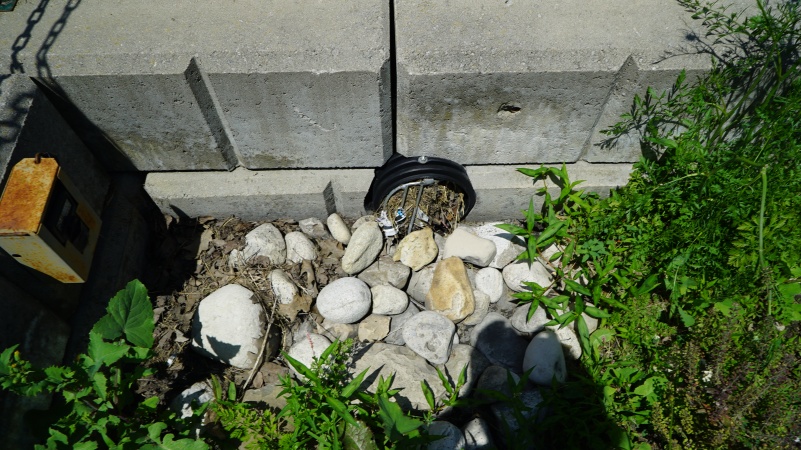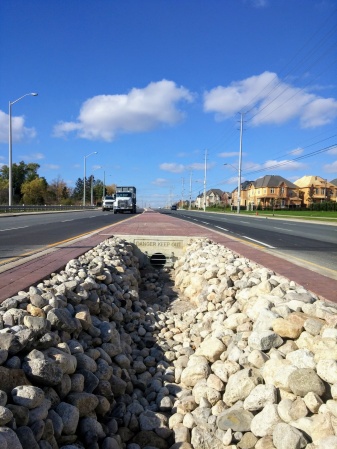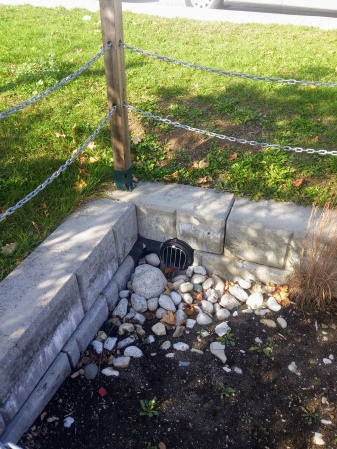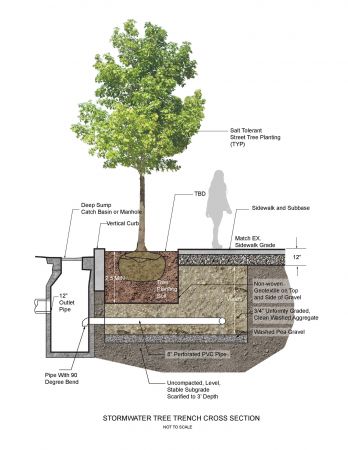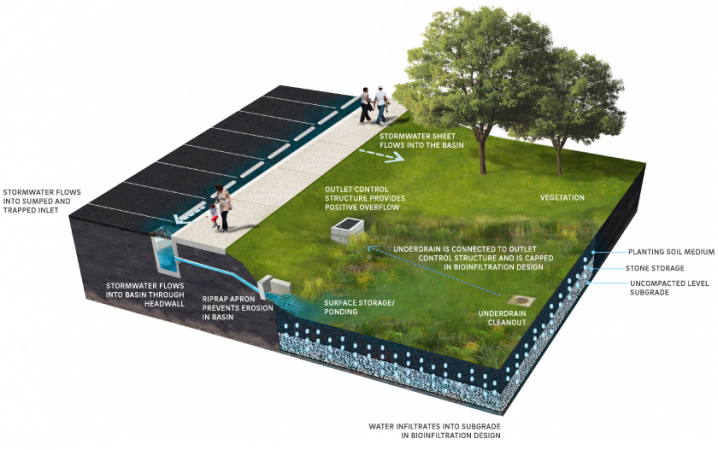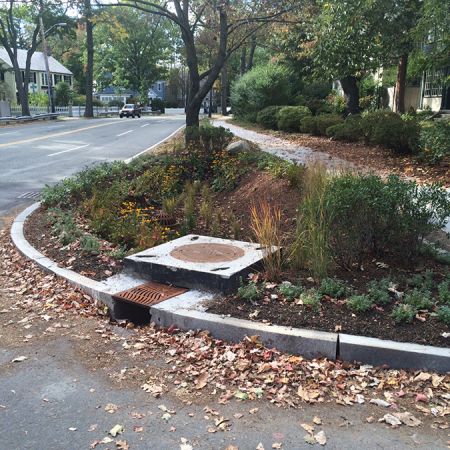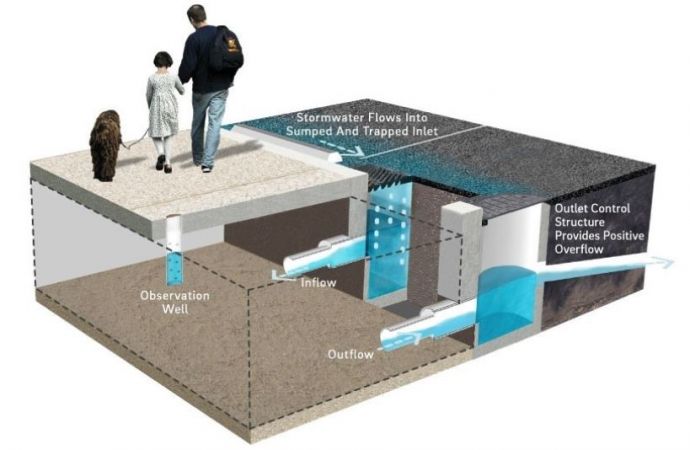Difference between revisions of "Inlet sumps: Gallery"
Jenny Hill (talk | contribs) m |
|||
| Line 1: | Line 1: | ||
<gallery mode="packed" widths=300px heights=300px> | <gallery mode="packed" widths=300px heights=300px> | ||
| + | Inlet - clogged - Elm Drive.JPG| A clogged inlet at the bioretention facility on Elm Drive in Mississauga in need of maintenance. | ||
Inlet Miss rd.jpg|This [[inlet]] channels flow from an underground pretreatment unit onto the surface of a large [[bioswale]], Mississauga Road, ON | Inlet Miss rd.jpg|This [[inlet]] channels flow from an underground pretreatment unit onto the surface of a large [[bioswale]], Mississauga Road, ON | ||
| − | Elm Drive Inlet.jpg|This [[bioretention]] facility is sunken from it's surrounding landscape, in part to accommodate the drop | + | Elm Drive Inlet.jpg|This [[bioretention]] facility is sunken from it's surrounding landscape, in part to accommodate the drop from the catchbasin inlet. Elm Drive, Mississauga, ON |
| − | + | Tree-trench+section+c-02.jpg|400px|A [[stormwater tree trench]], including a sump inlet design used as part of [[pretreatment]]. The feature is located in the City of Cambridge, Massachusetts, US. The design was developed and lead by HDR Inc., and Halvorson, Tighe & Bond Studio (Halvorson, Tighe & Bond Studio, n.d.)<ref>Halvorson, Tighe & Bond Studio. n.d. Halvorson, Tighe & Bond Studio. Retrieved from: https://www.halvorsondesign.com/willard-street-drainage</ref> | |
| + | Phila gov sump bio.png|Example of a sump inlet being used in conjunction with a large [[bioretention]] basin feature, located in park space receiving stormwater off of the adjacent roadway (Source: Philadelphia Water Department, n.d.)<ref>Philadelphia Water Department. n.d. Chapter 4 Stormwater Management Practice Guidance 4.1 Bioinfiltration/Bioretention. Retrieved from: https://water.phila.gov/development/stormwater-plan-review/manual/chapter-4/4-1-bioinfiltration-bioretention/</ref> | ||
| + | Nacto Sumpinlet bio.jpg| An inlet sump leading into a bioretention bump out for traffic calming. Inlet sumps help both settle and separate sediment from stormwater road runoff before depositing excess sediment and silt into an infiltration BMP. These sumps allow stormwater to flow into the feature through an [[underdrain]] pipe (Source: NACTO, 2017)<ref>National Association of City Transportation Officials (NACTO). 2017. Urban Street Stormwater Guide - Inlet Design. Retrieved from: https://nacto.org/publication/urban-street-stormwater-guide/stormwater-elements/bioretention-design-considerations/inlet-design/</ref> | ||
| + | File:Sump inelt to chamber system.JPG| Example of a sump inlet allowing sediment to settle out of influent stormwater before entering a large [[infiltration chamber]] housed under the parking lot (Source: Philadelphia Water Department. 2020)<ref>Philadelphia Water Department. 2020. Stormwater Management Guidance Manual: Version 3.2. Accessed from: https://www.pwdplanreview.org/upload/manual_pdfs/PWD-SMGM-v3.2-20201001.pdf</ref> | ||
</gallery> | </gallery> | ||
Revision as of 19:45, 13 October 2023
This bioretention facility is sunken from it's surrounding landscape, in part to accommodate the drop from the catchbasin inlet. Elm Drive, Mississauga, ON
A stormwater tree trench, including a sump inlet design used as part of pretreatment. The feature is located in the City of Cambridge, Massachusetts, US. The design was developed and lead by HDR Inc., and Halvorson, Tighe & Bond Studio (Halvorson, Tighe & Bond Studio, n.d.)[1]
Example of a sump inlet being used in conjunction with a large bioretention basin feature, located in park space receiving stormwater off of the adjacent roadway (Source: Philadelphia Water Department, n.d.)[2]
An inlet sump leading into a bioretention bump out for traffic calming. Inlet sumps help both settle and separate sediment from stormwater road runoff before depositing excess sediment and silt into an infiltration BMP. These sumps allow stormwater to flow into the feature through an underdrain pipe (Source: NACTO, 2017)[3]
Example of a sump inlet allowing sediment to settle out of influent stormwater before entering a large infiltration chamber housed under the parking lot (Source: Philadelphia Water Department. 2020)[4]
- ↑ Halvorson, Tighe & Bond Studio. n.d. Halvorson, Tighe & Bond Studio. Retrieved from: https://www.halvorsondesign.com/willard-street-drainage
- ↑ Philadelphia Water Department. n.d. Chapter 4 Stormwater Management Practice Guidance 4.1 Bioinfiltration/Bioretention. Retrieved from: https://water.phila.gov/development/stormwater-plan-review/manual/chapter-4/4-1-bioinfiltration-bioretention/
- ↑ National Association of City Transportation Officials (NACTO). 2017. Urban Street Stormwater Guide - Inlet Design. Retrieved from: https://nacto.org/publication/urban-street-stormwater-guide/stormwater-elements/bioretention-design-considerations/inlet-design/
- ↑ Philadelphia Water Department. 2020. Stormwater Management Guidance Manual: Version 3.2. Accessed from: https://www.pwdplanreview.org/upload/manual_pdfs/PWD-SMGM-v3.2-20201001.pdf
